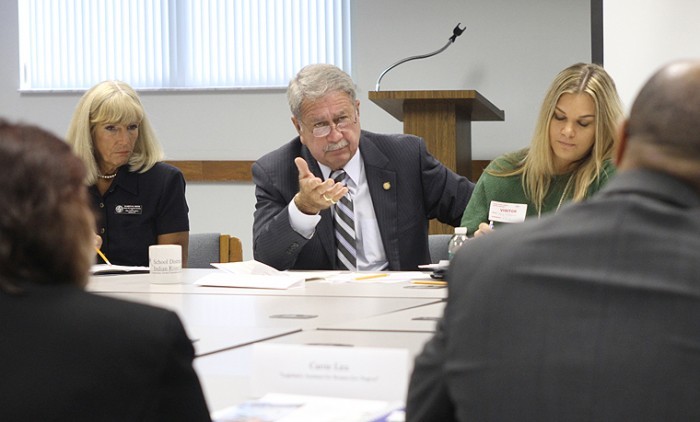
INDIAN RIVER COUNTY — Members of the Indian River County School Board sat down with representatives from Florida’s Legislature Thursday to request more funding and flexibility when it comes to unfunded state mandates.
“We want you to have us on your mind” when making decisions, Schools Superintendent Dr. Fran Adams told Rep. Debbie Mayfield, R-Vero Beach, Rep. Tom Goodson, R-Cocoa, Sen. Mike Haridopolos, R-Merrit Island, and aides to Sen. Joe Negron, R-Stuart, and Rep. Bill Posey, R-Rockledge.
Each School Board member gave a brief presentation highlighting the programs and progress the district has made despite steep budget cuts.
Assistant Superintendent of Finances Carter Morrison told the legislators that since the 2008-09 fiscal year, the district has cut $36 million and 300 positions – about 11 percent of the district’s workforce.
“We have tried desperately to keep cuts from classrooms,” Morrison said, adding, “There has been no stone left unturned. We are down to bare bones.”
Rep. Goodson spoke candidly to the School Board.
“You’re probably going to have the worst budget year,” Goodson said. “Property values are down. There are no jobs, all kinds of foreclosures. If I tell you it’ll be good, I’d be lying to you. It’s going to be brutal.”
He agreed with the School Board that the state must take responsibility for funding education, but the state has the added challenge of presenting a balanced budget.
School Board member Karen Disney-Brombach asked legislators to consider the possibility of exempting certain school districts when they craft “sweeping” mandates.
The School District-identified unfunded mandates cost about $14 million – money that could otherwise be put to use in classrooms and toward other needs.
“We’re doing something right, here,” Disney-Brombach said, despite the economic challenges.
The School District of Indian River County has been named a “high performing” district for two years – a feat not many districts in Florida can claim. The title is in recognition of fiscal responsibility as well as academic achievement.
Disney-Brombach floated the idea that so-named districts could be exempt from the mandates.
School Board member Carol Johnson told legislators that she understood why the legislators enact laws school districts must follow.
“It is for the abusers – not the achievers,” Johnson said, asking the legislators to re-tool their thinking when it comes time to crafting rules for districts.
She added she was hurt the State Legislature was considering forgiving school districts that did not follow class size rules when other districts, including Indian River County, worked hard to meet the requirements.
“That smarts guys,” Johnson said.
Rep. Mayfield questioned some of the services the School District provides, including voluntary pre-Kindergarten and Adult Education.
“We want to be all things to all people,” Rep. Mayfield said of school districts. She asked if such programs should be part of the School District’s core mission given that others in the community provide voluntary pre-K and Adult Education.
“It’s something we need to look at carefully,” School Board member Claudia Jimenez said. She argued that the district should offer VPK because, under the district, the program is held to a higher standard and is more accountable than a privately run program.
If VPK were to be offered solely by non-district organizations, Jimenez said there should be uniform training and standards of rigor for the program.
Dr. Adams told legislators that the district suffered a “devastating” loss when the state cut $179 per student in the VPK program.
She said the state had reasoned that it could pay less per child by allowing the district to have more children in each class.
“It never translates to that,” Dr. Adams said.
As for Adult Education, Rep. Mayfield pointed out that Indian River State College offers a similar program and asked about duplicating services.
“It’s very successful,” Dr. Adams said of the School District’s Adult Education program, adding that the district – with local control – can look at what the community’s needs are and provide education programs to fill that need.



